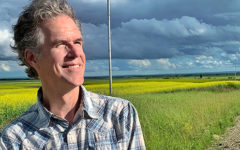
Ask Sonny Anything is a recurring feature where our readers pose questions to the great Sonny Osborne, one half of the iconic Osborne Brothers who redefined bluegrass music in the 1960s, and noted banjo maven and collector of fine prewar instruments. Everyone is encouraged to pose queries of your own each week in the comments, about his history in the music, his wealth of banjo knowledge, or regarding any life advice you might be needing.
First off this week I want to issue an apology to the musicians who were on stage setting up while I delivered my tremendous speech during Bill Emerson’s induction into the IBMA Hall of Fame. There was unbearable noise and racket loud enough to be heard by members of the audience. I received a note from one of the musicians, and was informed that the noise did not come from the pickers but it was actually the stage crew doing all the yelling and distracting racket. Honestly, it didn’t bother me as much as the audience. Seems to me the auditorium made enough $ that they would be able to hire stage setup people who are professional enough to go about their job quietly, and not to bother the show that is going on while making sure the audience does not hear them. Who knows… maybe the stage crew has family in the crowd who are listening for them to yell and make noise. Can’t you just hear them talking amongst themselves? “I bet that feedback we just heard was — and he said he would do that just for me!” I apologize pickers. It was not you!
Another tidbit of information you might be interested in knowing. Larry Mathis, banjo player and vocalist for the Pinnacle Boys in the ’60s-’70s has been fighting cancer, and I’m so happy to report that he is in remission and seemingly doing quite well. I had a conversation with Jim Smith and he had heard the good news also. Thank you Lord.
Sonny,
Who came up with the Gitjo? The pickin that you did on that was great! Also, when you worked for Bill Monroe, I was wondering In those days if they had you to do any of the driving?
Thanks, Mark K.
Driving Mister Bill. I did quite a lot as a matter of fact. A story goes with that, as I am sure you know or you wouldn’t have asked about driving specifically. So, I was 14 and had been driving since about 9 years old. My Aunt Cynthia had a ’46 Oldsmobile with a form of automatic transmission. She taught me to drive that car. Bill had a ’52 Chrysler and I was driving. Jimmy Martin, Charlie Cline, and I were in the front seat, Bill and Bessie Mauldin were in the back seat, and Bill was telling me every 5 minutes that we were going to be late. Two lane road between Burlington, NC, and on the way to Raleigh to play at the “Number one Drive In Theatre.” I was doing about 90 when I saw the red light flashing on a car about 500 yards behind us and I knew it was a police car, and he had me for speeding. He came up to the drivers window and asked for my drivers license. I politely told him I didn’t have one and he asked my age, I told him 14.
The nice policeman asked Bill if he knew I didn’t have a drivers license, Bill replied, “Ah, no sir I didn’t know!” Which we all knew was not true. The policeman? He told me to get out of the car, I did, and he politely informed me that I would be accompanying him to the police station. Going 90 MPH and having no drivers license was against the law, so, I was going to jail. Was I scared? Naw. Not a bit. Scared to death is more like it. He took me to the Burlington police station and told me if I would promise not to run, he wouldn’t put me in a cell. When it came time for him to go home, I went into a cell then! Man, when I heard that lock turn, it’s a feeling I won’t ever forget…not in this life. Kinda like hearing Earl start Flint Hill, or Tommy Jackson play Fraulein on Bobby Helm’s recording in 1956…nothing like it and something you will not soon forget. CLUNK!!!! Bill sent Jimmy and Charlie back to get me after their show… My fine was $65 which was supposed to be my per week salary… which I never once received. He didn’t give me any money the next week. Made me pay for the fine after telling me to go faster. Mr. Monroe at his finest!
The Guitjo was built by Greg Rich for Larry McNeely to use on the Glen Campbell TV show. I was told that it was never used because of the lack of volume. So when Larry moved back to Nashville he put it on consignment with George Gruhn. George showed it to me and I bought it. For my use, it worked perfectly. I loved the sound. What is it? It’s a copy of the Maccaferry, which is a copy of the great SELMER, a French classical guitar. I still have it. Joe Mullins used it once on a recording, and Aaron McDaris used it on a Rhonda Vincent song. It has an interesting inlay design created specifically for this guitar by Greg Rich. One of a kind.
—–
Hi Sonny. Thank You and Bobby for all the years of beautiful music.I loved all of your catalog, but Bluegrass Melodies rocked my world. never heard a prettier tune in bluegrass. Thank you again!
Dan S.
Hey Dan’l. Thank you for sharing your time with us!
I appreciate the kind words. It’s always nice to hear someone say they have enjoyed something you did. Bluegrass Melodies was written by Richard Stadler, a student at the University of Texas at the time. He also wrote Up This Hill and Down, My Favorite Memory, When You Wind Down… and more that other artists recorded. My Favorite Memory was the back side of Rocky Top so ole Rich made a pretty good haul that day.
—–
Hi Sonny, in my opinion, besides the banjo, you were also one of the great baritone singers. How did you learn that part and how would you tell someone how to sing it? When you listen to records, it’s easy to pick out the lead and tenor, but you can’t hear the baritone part well enough to tell what he’s doing. But, you can tell when there is no baritone singing also. Just wondering. Thanks for all you and Bobby have done for bluegrass. You guys had the best harmony!!
Roger A.
Roger, Thank you for coming right on in h’yer!
Most recording engineers, when they remix harmony singers, they mix the lead vocal a bit out front and the two harmony parts a click below that. I couldn’t see it that way. We mixed our trio so the parts were all equal in volume. We were so used to singing together that it was all equal values, and we knew how to make it sound that way on live shows. The best way for equality on vocal parts is a U87 or RE16. It’s been so long I might have those mics wrong. Good mics go a long way.
Singing, or just hearing parts is something that I’m NOT SURE CAN BE TAUGHT. A teacher can make one aware of the different parts, and the person is awakened to the fact that they hear and understand what the teacher is trying to get across, or it’s like a foreign language to them. Country/bluegrass harmony consists of 4 parts. (Or at least it does in my world) Tenor, Lead, Baritone, and Bass. Top to bottom. Lead being the absolute melody of the song. Tenor is one step above lead, baritone being one step below and bass below baritone. Now, here is where it can become tricky to the student. Imagine there are 4 lines, each being a part. Harmony is just what it implies, each part depends on another….it’s in harmony with another part. WOW…The Chief thinks he’s in over his head. If you want anything more I might have to enlist someone who knows more than I. I think I can do this but I will study on it and get back to you….😚 !
—–
Hi Sonny,
How DID your dad charge the battery on that old radio? Thanks a lot!
Mike R.
Mike. I’ve been thinking about this and I don’t really know. But I have friends in weird places who don’t know as much as I, and I have friends in stranger places who did know more. Jim Smith, whose folks had one of those radios which he has now. He was able to give me some insight on this radio subject. It appears that those radios had a dry cell battery which you didn’t charge, you got your Sears catalog from the out house and ordered a new battery. Problem solved.
—–
Sonny, Back in the day of the skin head, how did the banjo setup differ from then to the day of the plastic head…and what gauge strings did banjo players use.
Paul Thompson, Ohio
Paul, thanks for your time.
In the ’50s, the days of the skin head, the Rogers 3 star was considered the top of the line. Others were made but I don’t have a clue as to what the were. Cost about $25 and there was no guarantee, so when it split, good luck finding a head on a Saturday or Sunday afternoon. Best was to buy two or three at once. You had to master the art of mounting the thing too. Lots of times you had to settle for unmounted. And I clue you, if this was the case, you had better have someone show you how to do it. I ruined more than one with a razor blade. Then you had to worry about the tension. NO DRUM DIAL. You had to brush or tap the head and find out what tone the aforementioned brush or tap emitted. I have ridden for miles trying to dry a head… banjo out of the case laid to rest in the back window of the car… so the sun would hit it… Oh wait though…must not let the sun get it too tight or the —- thing would break. Voila…. you got to start all over again. Keeping a banjo sounding good was an everyday job. If you were playing Sunset Park, or New River Ranch and it was raining you got the head as tight as possible and hurried to the stage AND ALONG ABOUT HALFWAY THROUGH YOUR SHOW THE BOTTYOM WOULD DROP OUT. You’re playing Cumberland Gap and suddenly your right hand feels sorta spongy. This signals half a show of tuning.
String gauge? 1949…what was that. Black Diamond was small. Gibson was very big. Mapes, Bell Brand, Marlin. Black Diamond was good sounding and playing, but sometimes you could get one complete show out of them…and when they died, THEY DIED!
S
If you have something you would like to ask Sonny, be sure to post it in the comments below, or send it to us directly.







